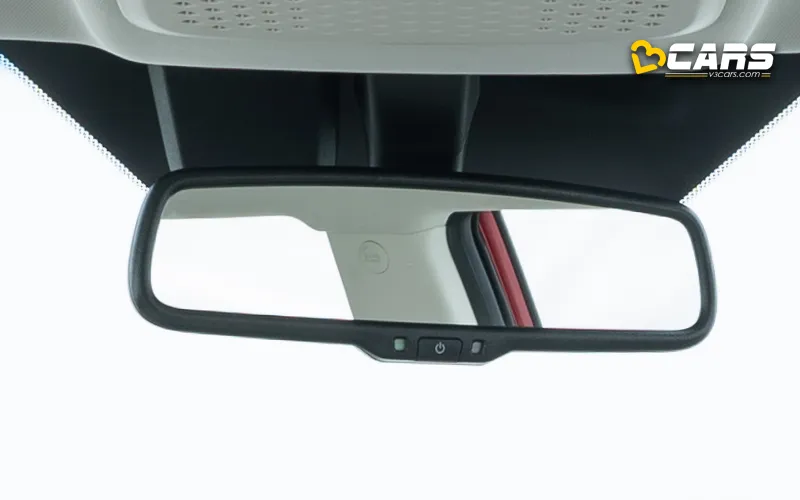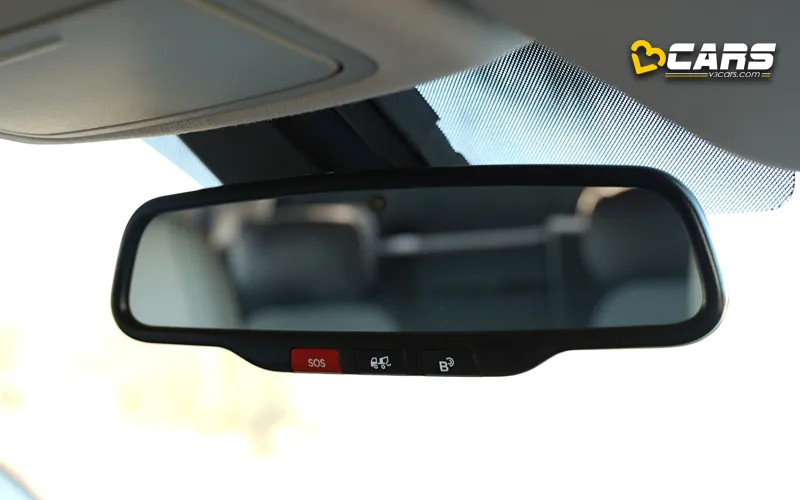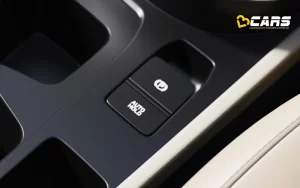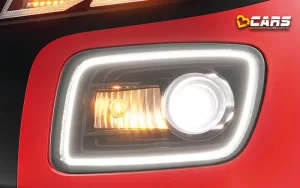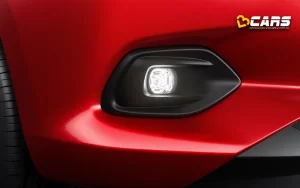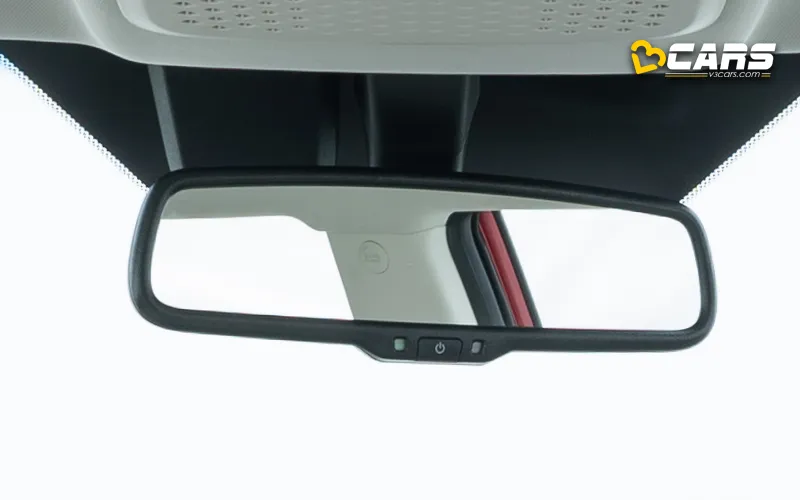
In this Feature Explained article, we’ll present the most detailed analysis of the manual day/night inside rear-view mirror. We’ll list out the pros and cons, explain how it works, provide the typical cost of getting a day/night inside mirror from the aftermarket, repair/replacement costs of a prismatic IRVM. Based on this analysis, we’ll suggest if you should add this feature to your car or skip it.
What Is IRVM Or Inside Rear View Mirror?
IRVM stands for Inside Rear View Mirror. It’s the mirror you use inside your car to see what’s happening behind you.
Most IRVMs are day/night mirrors, which means they have a feature that reduces the glare of headlights from vehicles behind you at night. This is important for safety, as bright headlights can make it difficult to see the road ahead.
There are two types of day/night IRVMs:
- Manual day/night IRVMs have a lever that you can use to switch between a regular reflective surface and a tinted surface. The tinted surface reduces the glare from headlights.
- Automatic day/night IRVMs have a light sensor that automatically dims the mirror when it detects bright headlights behind you.
A day/night inside mirror has 2 levels of reflections — brighter and darker — for driving during day and night. A flick switch helps us change between its day (bright) and night (dark) modes.
The day mode works like a normal mirror reflecting everything clearly through the rear windshield. The night mode is darker and it cuts down the intensity of reflections during night time to avoid glare from vehicles behind you using the high beam. There’s still enough reflection in the darker night mode of the IRVM that you can easily spot vehicles following you and plan your manoeuvres. However, it’s not so bright that it affects your forward visibility during night driving.
What Are The Pros And Cons Of Day/Night Inside Rear View Mirror (IRVM)?
Pros or advantages of manually-adjustable day/night mirrors:
- Budget-friendly: They’re a cost-effective choice compared to automatic options.
- DIY installation: For the mechanically inclined, self-installation saves on labor costs.
- Improved night visibility: Compared to standard mirrors, they can reduce some headlight glare.
Cons or negatives of manually-adjustable day/night mirrors:
- Manual adjustments: Frequent flipping between day and night modes can be distracting and inconvenient.
- Limited effectiveness: They don’t fully block glare, leading to eye strain and potential safety hazards.
- Readjustment needed: In some cars, changing modes might require readjusting the angle, adding another step.
How Does A Day/Night Inside IRVM Work?
A day/night inside mirror has 2 reflective surfaces inside shaped like a prism. One of them is a little darker than the other to cut down the glare during night driving. A mechanical switch under the mirror helps us switch between the day and night modes. Usually, the flick switch tilts the mirror just enough to toggle the mode of the IRVM without requiring any adjustments. However, in some cars, the mirror may require some readjustment everytime you change the mode.
How Expensive Is It To Repair Or Replace A Day/Night Inside Rear View Mirror?
Need a new day/night rearview mirror (IRVM)? Here’s what you need to know about costs, upgrades, and replacements:
Replacing a manually-adjustable inside rear view mirror (IRVM)
- Cost: Replacing usually falls between Rs. 2,000 and 3,500 for most cars.
- Upgrading: Consider a mirror from a higher variant of your car or a higher-end model. Shared parts across models might make it compatible. For example, my Nano got a Tiago’s day/night mirror!
- Windshield Replacement: If replacing the windshield, check if the old mirror’s clip mechanism is intact. If so, reuse it!
Repair vs. Replace:
- Repair: While possible, it’s rarely needed during a vehicle’s lifetime. In case of a loose ball joint or broken arm/mirror, replacement is usually easier.
Additional Tips:
- DIY Installation: For some cars, self-installation is possible, saving on labour costs.
- Professional Help: Glued mirrors are trickier and might require professional help for replacement.
Remember: Upgrading your IRVM can enhance safety and comfort, especially during night driving. Weigh the cost-benefit against your driving habits and needs.
What Is An Auto Dimming IRVM And How Does It Work?
An auto-dimming IRVM, also known as an automatic day/night mirror, is a type of rearview mirror that automatically adjusts its reflectiveness to reduce glare from headlights behind you. This improves safety and comfort while driving, especially at night.
An auto-dimming IRVM has sensors on both the front and rear sides. The front sensor detects the ambient light level. The rear sensor detects the light coming from behind your vehicle. If the rear sensor detects bright light, such as headlights from an oncoming vehicle, it sends a signal to a control unit. The control unit then applies a small voltage to a special liquid crystal (LC) layer within the mirror. The LC layer reacts to the voltage by changing its properties, effectively dimming the reflection of the bright lights.
What Is The Cost Of Aftermarket Day/Night Inside Rear-View Mirror?
In most mass market cars, adding a day/night inside mirror will typically cost you between Rs. 2,000 and 3,500. If you buy an OEM-spec manual day/night IRVM, then you could save about Rs. 500 to Rs. 1,000 depending on the compatible make and model.
How Easy Or Complex Is It To Install A Manual Day/Night Inside Rear-View Mirror?
Installing a day/night IRVM is usually a straightforward task. It’s usually attached to the windshield either with glue or clips into an attachment glued to the windshield.
If your car has the clip-type mechanism, then it’s super easy to install it in your car. You’ll have to carefully slide the existing IRVM out of the clip by pulling it towards the seats and away from the dashboard. Once it’s out, slide the new one in until it clicks and you’re good to go.
If your car holds on to the inside mirror with glue, then you’ll have to pry hard to remove the old mirror in the first place. Once it’s out, you’ll have to use double-tape to fix the new one. While doing so, you will need to hold the mirror in place until the glue dries out. This process is not suitable for self installation. So, we’ll recommend getting some professional help in this case.
What Cars Get A Day/Night Inside Rear View Mirror From The Factory?
All cars under Rs. 10.0 lakh (ex-showroom) get the day/night inside rear view mirror at least in some variants. Alto is the only car currently on sale, which doesn’t offer a day/night inside mirror even in the top variant.
Verdict – Should I Get An Aftermarket Day/Night Inside Rear-View Mirror (IRVM)?
If your car didn’t come with a day/night inside mirror from the factory, then we highly recommend getting this feature after purchase. You can ask your car dealer or service centre to install it for you. It’s also fairly easy to find a compatible day/night inside mirror for your car from the aftermarket.
Once you use this feature in a car, it’s difficult to go back to a plain-Jane inside rear-view mirror. Considering the cost and simplicity of installing this feature on any car and the comfort, convenience and safety it offers during night driving, a day/night inside mirror is a must have feature for all car owners.
Note: Check your Car EMI with our – Car Loan EMI Calculator
You can use our Fuel Cost Calculator to see how any petrol, diesel or CNG car will cost to run based on the latest fuel price in your city.

